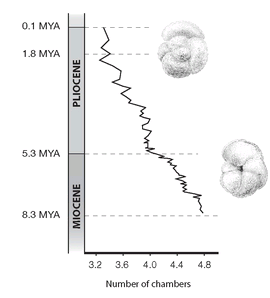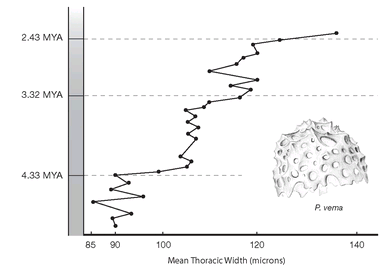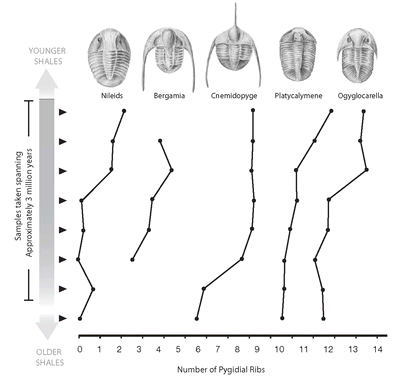Why Evolution Is True (7 page)
Read Why Evolution Is True Online
Authors: Jerry A. Coyne

What Darwin didn’t have were enough fossils to show clear evidence of gradual changes within species, or of common ancestors. But since his time, paleontologists have turned up fossils galore, fulfilling all the predictions mentioned above. We can now show continuous changes within lineages of animals; we have lots of evidence for common ancestors and transitional forms (those missing ancestors of whales, for instance, have turned up); and we have dug deep enough to see the very beginnings of complex life.
Big PatternsNow that we have put all the strata in order and estimated their dates, we can read the fossil record from bottom to top. Figure 3 shows a simplified timeline of life’s history, depicting the major biological and geological events that occurred since the first organisms arose around 3.5 billion years ago.
6
This record gives an unambiguous picture of change, starting with the simple and proceeding to the more complex. Although the figure shows the “first appearances” of groups like reptiles and mammals, this shouldn’t be taken to mean that modern forms appear in the fossil record suddenly, arising out of nowhere. Instead, for most groups we see gradual evolution from earlier forms (birds and mammals, for example, evolved over millions of years from reptilian ancestors). The existence of gradual transitions between major groups, which I discuss below, means that assigning a date to a “first appearance” becomes somewhat arbitrary.
6
This record gives an unambiguous picture of change, starting with the simple and proceeding to the more complex. Although the figure shows the “first appearances” of groups like reptiles and mammals, this shouldn’t be taken to mean that modern forms appear in the fossil record suddenly, arising out of nowhere. Instead, for most groups we see gradual evolution from earlier forms (birds and mammals, for example, evolved over millions of years from reptilian ancestors). The existence of gradual transitions between major groups, which I discuss below, means that assigning a date to a “first appearance” becomes somewhat arbitrary.

FIGURE 3.
The fossil record showing first appearance of various forms of life that arose since the earth formed 4,600 million years ago (MYA). Note that multicellular life originated and diversified only in the last 15 percent of life’s history. Groups appear on the scene in an orderly evolutionary fashion, with many arising after known fossil transitions from ancestors.
The fossil record showing first appearance of various forms of life that arose since the earth formed 4,600 million years ago (MYA). Note that multicellular life originated and diversified only in the last 15 percent of life’s history. Groups appear on the scene in an orderly evolutionary fashion, with many arising after known fossil transitions from ancestors.
The first organisms, simple photosynthetic bacteria, appear in sediments about 3.5 billion years old, only about a billion years after the planet was formed. These single cells were all that occupied the earth for the next 2 billion years, after which we see the first simple “eukaryotes”: organisms having true cells with nuclei and chromosomes. Then, around 600 million years ago, a whole gamut of relatively simple but multicelled organisms arise, including worms, jellyfish, and sponges. These groups diversify over the next several million years, with terrestrial plants and tetrapods (four-legged animals, the earliest of which were lobe-finned fish) appearing about 400 million years ago. Earlier groups, of course, often persisted: photosynthetic bacteria, sponges, and worms appear in the early fossil record, and are still with us.
Fifty million years later we find the first true amphibians, and after another 50 million years reptiles come along. The first mammals show up around 250 million years ago (arising, as predicted, from reptilian ancestors), and the first birds, also descended from reptiles, show up 50 million years later. After the earliest mammals appear, they, along with insects and land plants, become ever more diverse, and as we approach the shallowest rocks, the fossils increasingly come to resemble living species. Humans are newcomers on the scene—our lineage branches off from that of other primates only about 7 million years ago, the merest sliver of evolutionary time. Various imaginative analogies have been used to make this point, and it is worth making again. If the entire course of evolution were compressed into a single year, the earliest bacteria would appear at the end of March, but we wouldn’t see the first human ancestors until 6 a.m. on December 31. The golden age of Greece, about 500 BC, would occur just thirty seconds before midnight.
Although the fossil record of plants is sparser—they lack easily fossilized hard parts—they show a similar evolutionary pattern. The oldest are mosses and algae, followed by the appearance of ferns, then conifers, then deciduous trees, and, finally, flowering plants.
So the appearance of species through time, as seen in fossils, is far from random. Simple organisms evolved before complex ones, predicted ancestors before descendants. The most recent fossils are those most similar to living species. And we have transitional fossils connecting many major groups. No theory of special creation, or
any
theory other than evolution, can explain these patterns.
Fossilized Evolution and Speciationany
theory other than evolution, can explain these patterns.
To show gradual evolutionary change within a single lineage, you need a good succession of sediments, preferably laid down quickly (so that each time period represents a thick slice of rock, making change easier to see), and without missing layers (a missing layer in the middle makes a smooth evolutionary transition look like a sudden “jump”).
Very small marine organisms, such as plankton, are ideal for this. There are billions of them, many with hard parts, and they conveniently fall directly to the seafloor after death, piling up in a continuous sequence of layers. Sampling the layers in order is easy: you can thrust a long tube into the seafloor, pull up a columnar core sample, and read it (and date it) from bottom to top.

FIGURE 4
. A record of fossils (preserved in a seafloor core) showing evolutionary change in the marine foraminiferan
Globorotalia conoidea
over an eight-million-year period. The scale gives the number of chambers in the final whorl of the shell, averaged among all individuals counted in each section of the core.
. A record of fossils (preserved in a seafloor core) showing evolutionary change in the marine foraminiferan
Globorotalia conoidea
over an eight-million-year period. The scale gives the number of chambers in the final whorl of the shell, averaged among all individuals counted in each section of the core.
Tracing a single fossil species through the core, you can often see it evolve. Figure 4 shows an example of evolution in a tiny, single-celled marine protozoan that builds a spiral shell, creating more chambers as it grows. These samples come from sections of a two-hundred-meter-long core taken from the ocean floor near New Zealand, representing about eight million years of evolution. The figure shows change over time in one trait: the number of chambers in the final whorl of the shell. Here we see fairly smooth and gradual change over time: individuals have about 4.8 chambers per whorl at the beginning of the sequence and 3.3 at the end, a decrease of about 30 percent.
Evolution, though gradual, need not always proceed smoothly, or at an even pace. Figure 5 shows a more irregular pattern in another marine microorganism, the radiolarian
Pseudocubus vema.
In this case geologists took regularly spaced samples from an eighteen-meter-long core extracted near Antarctica, representing about two million years of sediments. The trait measured was the width of the animal’s cylindrical base (its “thorax”). Although size increases by nearly 50 percent over time, the trend is not smooth. There are periods in which size doesn’t change much, interspersed with periods of more rapid change. This pattern is quite common in fossils, and is completely understandable if the changes we see were driven by environmental factors such as fluctuations in climate or salinity. Environments themselves change sporadically and unevenly, so the strength of natural selection will wax and wane.
Pseudocubus vema.
In this case geologists took regularly spaced samples from an eighteen-meter-long core extracted near Antarctica, representing about two million years of sediments. The trait measured was the width of the animal’s cylindrical base (its “thorax”). Although size increases by nearly 50 percent over time, the trend is not smooth. There are periods in which size doesn’t change much, interspersed with periods of more rapid change. This pattern is quite common in fossils, and is completely understandable if the changes we see were driven by environmental factors such as fluctuations in climate or salinity. Environments themselves change sporadically and unevenly, so the strength of natural selection will wax and wane.

FIGURE 5
. Evolutionary change of thorax size in the radiolarian
Pseudocubus vema
over a period of two million years. Values are population averages from each section of the core.
. Evolutionary change of thorax size in the radiolarian
Pseudocubus vema
over a period of two million years. Values are population averages from each section of the core.

FIGURE 6.
Evolutionary change in the number of “pygidial ribs” (segments on the rear section) of five groups of Ordovician trilobites. The number gives the population average at each section of the three-million-year sample of shale. All five species—and three others not shown—displayed a net increase in rib number over the period, suggesting that natural selection was involved over the long term, but that the species did not change in perfect parallel.
Evolutionary change in the number of “pygidial ribs” (segments on the rear section) of five groups of Ordovician trilobites. The number gives the population average at each section of the three-million-year sample of shale. All five species—and three others not shown—displayed a net increase in rib number over the period, suggesting that natural selection was involved over the long term, but that the species did not change in perfect parallel.
Let’s look at evolution in a more complex species: trilobites. Trilobites were arthropods, in the same group as insects and spiders. Since they were protected by a hard shell, they are extremely common in ancient rocks (you can probably buy one in your nearest museum shop). Peter Sheldon, then at Trinity College Dublin, collected trilobite fossils from a layer of Welsh shale spanning about three million years. Within this rock, he found eight distinct lineages of trilobites, and over time each showed evolutionary change in the number of “pygidial ribs”—the segments on the last section of the body. Figure 6 shows the changes in several of these lineages. Although over the entire period of sampling every species showed a net increase in segment number, the changes among different species were not only uncorrelated, but sometimes went in opposite directions during the same period.
Unfortunately, we have no idea what selective pressures drove the evolutionary changes in these plankton and trilobites. It is always easier to document evolution in the fossil record than to understand what caused it, for although fossils are preserved, their environments are not. What we can say is that there was evolution, it was gradual, and it varied in both pace and direction.
Marine plankton give evidence for the splitting of lineages as well as evolution within a lineage. Figure 7 shows an ancestral plankton species dividing into two descendants, distinguishable by both size and shape. Interestingly, the new species,
Eucyrtidium matuyamai,
first evolved in an area to the north of the area from where these cores were taken, and only later invaded the area where its ancestor occurred. As we’ll see in chapter 7, the formation of a new species usually begins when populations are geographically isolated from one another.
Eucyrtidium matuyamai,
first evolved in an area to the north of the area from where these cores were taken, and only later invaded the area where its ancestor occurred. As we’ll see in chapter 7, the formation of a new species usually begins when populations are geographically isolated from one another.
There are hundreds of other examples of evolutionary change in fossils—both gradual and punctuated—from species as diverse as mollusks, rodents, and primates. And there are also examples of species that barely change over time. (Remember that evolutionary theory does not state that
all
species must evolve!) But listing these cases wouldn’t change my point: the fossil record gives no evidence for the creationist prediction that all species appear suddenly and then remain unchanged. Instead, forms of life appear in the record in evolutionary sequence, and then evolve and split.
“Missing Links”all
species must evolve!) But listing these cases wouldn’t change my point: the fossil record gives no evidence for the creationist prediction that all species appear suddenly and then remain unchanged. Instead, forms of life appear in the record in evolutionary sequence, and then evolve and split.
Changes in marine species may give evidence for evolution, but that’s not the only lesson that the fossil record has to teach. What really excites people-biologists and paleontologists among them—are
transitzonal forms:
those fossils that span the gap between two very different kinds of living organisms. Did birds really come from reptiles, land animals from fish, and whales from land animals? If so, where is the fossil evidence? Even some creationists will admit that minor changes in size and shape might occur over time—a process called
microevolution—but
they reject the idea that one
very different
kind of animal or plant can come from another
(macroevolution).
Advocates of intelligent design argue that this kind of difference requires the direct intervention of a creator.
7
Although in
The Origin
Darwin could point to no transitional forms, he would have been delighted by how his theory has been confirmed by the fruits of modern paleontology. These include numerous species whose existence was predicted many years ago, but that have been unearthed in only the last few decades.
transitzonal forms:
those fossils that span the gap between two very different kinds of living organisms. Did birds really come from reptiles, land animals from fish, and whales from land animals? If so, where is the fossil evidence? Even some creationists will admit that minor changes in size and shape might occur over time—a process called
microevolution—but
they reject the idea that one
very different
kind of animal or plant can come from another
(macroevolution).
Advocates of intelligent design argue that this kind of difference requires the direct intervention of a creator.
7
Although in
The Origin
Darwin could point to no transitional forms, he would have been delighted by how his theory has been confirmed by the fruits of modern paleontology. These include numerous species whose existence was predicted many years ago, but that have been unearthed in only the last few decades.
Other books
Andy Kaufman Revealed! by Bob Zmuda
Gypsy Lady by Shirlee Busbee
A Trick I Learned From Dead Men by Kitty Aldridge
The Star Plume by Kae Bell
The Outlaws by Toombs, Jane
Pure Lust (Lust for Life) by Jayne Kingston
Much Ado About Mavericks by Jacquie Rogers
Yearbook by David Marlow
Baby Before Business (Silhouette Romance) by Susan Meier
Last Breath by Diane Hoh
